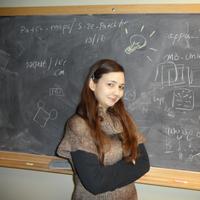Papers by Claudia Antolini

We reconstruct shear maps and angular power spectra from simulated weakly lensed total intensity ... more We reconstruct shear maps and angular power spectra from simulated weakly lensed total intensity (T T ) and polarised (EB) maps of the Cosmic Microwave Background (CMB) anisotropies, obtained using Born approximated ray-tracing through the N-body simulated Cold Dark Matter (CDM) structures in the Millennium Simulations (MS). We compare the recovered signal with the ΛCDM prediction, on the whole interval of angular scales which is allowed by the finite box size, extending from the degree scale to the arcminute, by applying a quadratic estimator in the flat sky limit; we consider PRISM-like instrumental specification for future generation CMB satellites, corresponding to arcminute angular resolution of 3.2 and sensitivity of 2.43 µK-arcmin. The noise bias in the simulations closely follows the estimator prediction, becoming dominated by limits in the angular resolution for the EB signal, at 1500. The de-biased signal shows no visible departure from predictions of the weak lensing power within uncertainties, when considering T T and EB data singularly. In particular, the reconstruction precision reaches the level of a few percent in bins with ∆ 100 in the angular multiple interval 1000 2000 for T , and about 10% for EB. Within the adopted specifications, polarisation data do represent a significant contribution to the lensing shear, which appear to faithfully trace the underlying N-body structure down to the smallest angular scales achievable with the present setup, validating at the same time the latter with respect to semi-analytical predictions from ΛCDM cosmology at the level of CMB lensing statistics. This work demonstrates the feasibility of CMB lensing studies based on large scale simulations of cosmological structure formation in the context of the current and future high resolution and sensitivity CMB experiment.
Aims. To teach the topic of Dark Matter in Galaxies to undergraduate and PhD students is not easy... more Aims. To teach the topic of Dark Matter in Galaxies to undergraduate and PhD students is not easy, one reason being that the scientific community has not converged yet to a generally shared knowledge. Methods. We argue that the teaching of this topic and its subsequent scientific progress may benefit by Massive Online and Open Courses.

We evaluate our capability to constrain the abundance of primordial tensor perturbations in cosmo... more We evaluate our capability to constrain the abundance of primordial tensor perturbations in cosmologies with generalized expansion histories in the epoch of cosmic acceleration. Forthcoming satellite and sub-orbital experiments probing polarization in the CMB are expected to measure the B-mode power in CMB polarization, coming from PGWs on the degree scale, as well as gravitational lensing on arcmin scales; the latter is the main competitor for the measurement of PGWs, and is directly affected by the underlying expansion history, determined by the presence of a DE component. In particular, we consider early DE possible scenarios, in which the expansion history is substantially modified at the epoch in which the CMB lensing is most relevant. We show that the introduction of a parametrized DE may induce a variation as large as 30% in the ratio of the power of lensing and PGWs on the degree scale. We find that adopting the nominal specifications of upcoming satellite measurements the constraining power on PGWs is weakened by the inclusion of the extra degrees of freedom, resulting in a reduction of about 10% of the upper limits on r in fiducial models with no GWs, as well as a comparable increase in the error bars in models with non-zero r. Moreover, we find that the inclusion of sub-orbital CMB experiments, capable of mapping the B-mode power up to the angular scales affected by lensing, can restore the forecasted performances with a cosmological constant. Finally, we show how the combination of CMB data with Type Ia SNe, BAO and Hubble constant allows to constrain simultaneously r and the DE quantities in the parametrization we consider, consisting of present abundance and first redshift derivative of the energy density. We compare this study with results obtained using the forecasted lensing potential measurement precision from CMB satellite observations, finding consistent results.




Uploads
Papers by Claudia Antolini